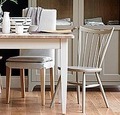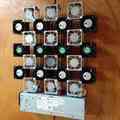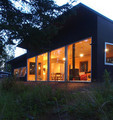Mischer’traxler’s ‘Reversed Volumes’ Bowls are Cast From Fruits and Vegetables
by: Inhabitat , 2014-09-20 14:12:35 UTC

Vienna-based Mischer’traxler captured the textures and shapes of different vegetables to create a colorful line of tablewear. Called Reversed Volumes, the long-lasting ceramic vessels are imprinted with the forms of veggies and fruits, and each bowl is as unique as the piece of produce that produced it.










Read the rest of Mischer’traxler’s ‘Reversed Volumes’ Bowls are Cast From Fruits and Vegetables
Permalink | Add to del.icio.us | digg
Post tags: Art, bowls, green home decor, MischerTraxler, Reversed Volumes, vegetables shapes, vegetables textures
 Designs that take prosthetics to an all new level
Designs that take prosthetics to an all new level
by: The Design blog, 2014-09-20 06:35:34 UTC
There is no doubt in the fact that only the amputee knows pain of losing limbs but there are some designers who also have understood this pain and have come up with some prosthetic limb concepts that are adept at making the life of an amputee way more comfortable and independent. Following are some designs that could make prosthetics way more useful, in form, function, and even expression.

Immaculate Prosthetic Limbs
Immaculate prosthetic limb designed by Alexander Huseklepp is just a concept at the moment. The designer has put in a lot of effort to make this concept very effective and good looking. It looks like a robot’s arm that can be a fashion statement for a disabled person and the limb can largely bring back the lost performance of the amputee. The prosthetic limb is made of corian plates and dome-joints that are flexible.

CADENCE prosthetic leg
This concept aims to improve the performance of the paraplegic cyclists. Designer Seth Aslie is behind the creation of this amazing concept called CADENCE. It will allow the cyclists to pedal in a proper circular motion, as the limb gives their leg a natural movement. An elastomeric band at the front of the prosthetic leg gathers energy when the cyclist pedals forward. The split toe design offers an easy clipping and unclipping function to the cyclist, thus, bettering his performance.

Adidas Symbiosis Prosthesis
This is a prosthetic limb concept that has called for the usage of unique materials like carbon fiber, Sorbothane, electromagnetic steel, and aluminum. In comparison to many other concepts, this looks more promising to help the amputees lead a better life. The electromagnets substitute human muscles and send a wireless signal that leads to a normal movement.

Affordable Prosthetic Concept
Designer Dana Bedeen understood the fact that it is not possible for many amputees to buy prosthetics due to their high costs, and has come up with a concept that is quite affordable. Besides affordability, the factors that Dana has taken into consideration are look and comfort. The prosthetic design will be made from high impact resistant polycarbonate.

Sensitive Touch Glove
Smart Gloves is a concept that will replace lifeless and unmoving prosthetic substitutes. Smart gloves move and enable the amputee to feel things. Daniel Kamp has designed sensitive touch glove to give some sensation back to the missing arms.
Summary
The coming times seem to be quite beneficial for amputees, as several designers are putting in efforts to invent such prosthetic limbs that can give the disabled an easy and an independent life.
A Renovated, Bauhaus-Style House in Hamble-le-Rice
by: design milk, 2014-09-09 17:00:15 UTC

This project, House in Hamble-le-Rice, consisted of a complete renovation, extension, and a roof terrace addition by LA Hally Architect. The Bauhaus style home sits on the edge of the River Hamble and is a part of Crowsport Estate, a 1930s property commissioned by Sir Thomas Lipton (you know, the tea man). Architect Robert Cromie was the designer for the group of homes, including this one, that overlooks the marina.

The original home was in desperate need of repair and over the years it had been altered and lost its original charm. LA Hally Architect was hired to modernize the property while keeping the architecture original to the style and area.

Extensions were needed for the kitchen and living areas to become an open floor plan kitchen, music room, and office, as well as the rooftop terrace that provides views of the marina.

Glass railings were used to keep the sight lines open to the water and they help give the space a clean, modern feel.

The living space opens ups to a massive patio that flows right to the grass outside.



They removed all of the changes in the floor levels and used a bleached wood floor throughout the property to keep continuity.





Photos by Joel Knight.






 Blue-violet LED Used to Sterilize Resistant Bacteria
Blue-violet LED Used to Sterilize Resistant Bacteria
by: Tech-On! : tech news - straight from Asia., 2014-09-01 00:10:00 UTC
A research group at Osaka City University succeeded in treating a skin ulcer infected with methicillin-resistant staphylococcus aureus (MRSA) by (1) the systemic administration of natural amino acid (5-aminolevulinic acid: ALA) and (2) a photodynamic therapy (PDT) using LED light.
‘Green Bonds’ and What Makes Them Green
by: Environmental Leader, 2014-09-02 15:16:22 UTC
There’s been a surge of interest among companies in issuing green bonds to raise capital to invest in renewable energy and other environmental improvement projects, helping them to achieve their sustainability goals. Proceeds from Unilever’s £250m green bond will go towards installing cleaner production facilities, while GDF Suez’s €2.5bn green bond – the largest issuance […]
 Sanctuaria: Where Design Meets Biology
Sanctuaria: Where Design Meets Biology
by: design milk, 2014-09-01 14:00:03 UTC

Morgan Ruben Jansen op de Haar recently graduated from the Utrecht School of the Arts in Product Design where he created Sanctuaria as his graduate project.
Sanctuaria consists of a series of capsules that contain endangered rainforest flora such as orchids, ferns and mosses that will be able to survive regardless of what happens to their natural habitat. The project features two as of yet unnamed species of orchid obtained from cut trees in Asia, their homeland already destroyed. Within the capsules they find their last refuge.


The capsules are suspended within frames made of wood, stone and metal—materials that have been used by man in almost every era. The plants themselves are grown on durable synthetic materials such as hygrolon and Perspex.



The inspiration for this project comes from Morgan’s lifelong fascination with nature and its complex ecosystems as well as his experience interning with Formafantasma.
The project was made possible with support by a botanist from the Hortus Botanicus Leiden, the Glassworkshop of the Utrecht University and the research institute Fraunhofer COMEDD.













Comments by our Users
Be the first to write a comment for this item.